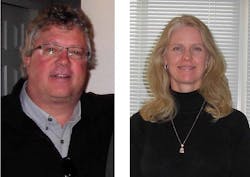Lay It Down
Hydraulically applied mulches often are cheaper to apply than other erosion and sediment control measures, especially in larger areas, and they have better contact to the ground than rolled erosion control blankets (RECBs).
The two basic types of hydromulch are paper and wood. There have been some new product introductions since the early 1990s that are well suited for long-term coverage as well; these products are known as bonded fiber matrix (BFM), fiber-reinforced matrix (FRM) and flexible growth medium (FGM). Prices range from low to high, with paper being the least expensive (and the fastest degrading) and FRMs costing more.
Paper hydromulch is manufactured from recycled paper products, usually newspapers. It is not ideal for arid regions, in part because of the additional time needed to establish revegetation. Paper hydromulch does not last long and does not hold water as well as wood mulches, but will last longer when used in conjunction with a tackifier. The normal application rate is 2,000 lb per acre.
Wood fiber hydromulch is the most commonly used mulch in arid parts of the U.S. because of its moisture-holding capacity. It is manufactured by taking virgin wood or recycled wood fibers and putting them through a machine to form different sizes. The best hydromulch has many different fiber lengths to it, so that when it is applied to the ground, it will form a cover to protect the seed and soil from wildlife and erosion. When used in conjunction with a tackifier, hydromulch will be stronger and last longer. Normal application rate is 2,000 lb per acre.
Wood/paper mixture typically is used in the western part of the country in post-fire revegetation projects. This combination provides a “papier-mâché adhesion” to help the wood mulch increase its stability.
BFMs are hydraulically applied products that are designed, tested and proven to match or exceed the performance of RECBs. They comprise the same wood fibers as hydromulch, but there is a cross-linker added to increase strength and longevity.
FRMs are manufactured using the same quality wood fibers as hydromulch, along with synthetic fibers and exclusive bonding materials that will stabilize and strengthen some of the most difficult sites.
These products are designed so that one can apply them in the rain, and so that they will bond securely to the soils without becoming too thin. The synthetic fibers allow the FRM to loft on the ground, making it easier for plants to come through the crust.
All of these products should be applied from a hose or the turret of a hydroseeder from as many different directions as possible to make a “hydraulically applied blanket.” This process will eliminate bare spots from all angles, and it will protect the seed and any amendments from direct raindrop impact while still allowing moisture to pass through—but not rehydrate—the crust. The normal application rate is 3,000 to 4,000 lb per acre, depending on the soil types and slope composition.
The longevity of all of these products will depend on ultraviolet degradation, environmental circumstances, wildlife, and foot and construction traffic.
When considering a hydraulic product, decide how long it needs to last, how steep the slopes are, what type of seed is specified, etc. These factors will help you to decide which product is best to use for a specific site and its conditions.


